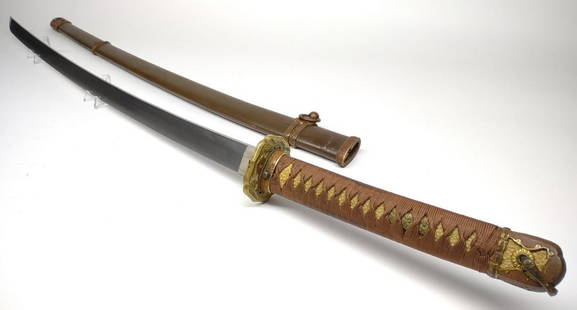
Japanese Katana Sword with Scabbard
Similar Sale History
View More Items in Weapons & Armor
Related Weapons & Armor
More Items in Japanese Weapons & Armor
View MoreRecommended Collectibles
View More


Item Details
Description
Koto Period, before 1595 A.D. and later. A katana with curved single edged blade showing straight hamon edge-pattern, straight plain nakago-jiri tang pierced with one mekugi-ana hole for the insertion of a bamboo pin, circular copper-alloy tsuba hand guard (a later replacement) pierced with a flower shaped aperture, later fabric bound sharkskin tsuka-ito covered grip with a pair of copper-alloy menuki metal ornaments, a squared copper-alloy kabuto gane pommel and a fuchi metal sleeve, followed by a seppa metal spacer with jagged edge; accompanied by a later saya russet lacquered scabbard with copper-alloy fittings; the original blade later shortened by about 75mm. See Turnbull, S., Samurai Warriors, Poole, 1987; Bryant, A.J., The Samurai, London, 1989; Bryant, A.J., Samurai, 1550-1600, London, 1994; Turnbull, S., Samurai Warfare, London, 1996. 1.22 kg total, 93 cm long (36 5/8 in.). Acquired from an Essex, UK collector by exchange. Property of an Essex gentleman. Accompanied by a report by military specialist Dr. Raffaele D'Amato. Tokugawa Ieyasu, the famous Shogun who unified the Japan between 1600 and 1615, said: ‘In the event that a Samurai loses his sword, it is an unforgivable fact, because the sword is the soul of the Samurai.’ The long katana and the shorter wakizashi were the two main swords (the ‘blade’ and the ‘companion’) of the Samurai in the wars of the Sengoku period. But it was the katana, the single-edged long sword, which was considered by philosophers and sword masters, such as Miyamoto Musashi (1584-1645), to ruling element of the world and therefore the basis of martial arts. The ancient swords, like our specimen, were called Koto, if forged before 1596 A.D. Made with iron ores and steel collected from the Japanese deposits, these swords had marked regional characteristics, as a consequence of the place of manufacture. The five most famous schools or traditions (Gokaden) were located in the mining provinces of Yamashiro, Yamato, Bizen, Sagami and Mino. Japanese swords were famous over the world for their high quality. The blade, a layer of strong, hard steel between more flexible layers, was perhaps the finest non-surgical cutting tool ever made. The swordsmiths (katana-kaji), after the rituals of purification and propitiation, began forging of the blade from a rough iron plate (tamahagane) having a high content of carbon (around 15%). Then, through successive bending and folding operations, they expelled the impure elements from the iron and regulated the quantity of carbon, obtaining a plate composed of molecular layers of steel. Finally then inserted layers of mild steel (shingane) into the hard steel (kawagane) blade under construction. At the end they modelled the flat and long blade which, through the tempering (yakiire) assumed its unmistakable curvature and its unsurpassed hardness. This sword, probably made in the last bloody period of the Senkogu wars, was preserved for centuries and later shortened in its blade, to be fitted with a new hilt and scabbard and probably carried by a Japanese officer in the late 19th or early 20th wars of the new Nippon Empire.
Buyer's Premium
- 35%
Japanese Katana Sword with Scabbard
Estimate £1,500 - £2,000
21 bidders are watching this item.
Shipping & Pickup Options
Item located in MayFair, London, ukSee Policy for Shipping
Payment

Related Searches
TOP





























































![George Washington Signed Discharge: Partly printed discharge document signed by George Washington, as Commander in Chief of the Armies of the United States. Newburgh, [New York], 4 January 1783. 1 page, ## x ## in. Undersigned by Washin](https://p1.liveauctioneers.com/7226/322253/173251475_1_x.jpg?height=310&quality=70&version=1710004847)
![[Ambrotype] Texas Confederate Soldier: Sixth plate ambrotype. Full leatherette case. Portrait of a possible Texas Confederate soldier. A silver star device was used to pin up the brim of his light-toned headgear, a look often seen in image](https://p1.liveauctioneers.com/7226/322253/173251509_1_x.jpg?height=310&quality=70&version=1710004847)




